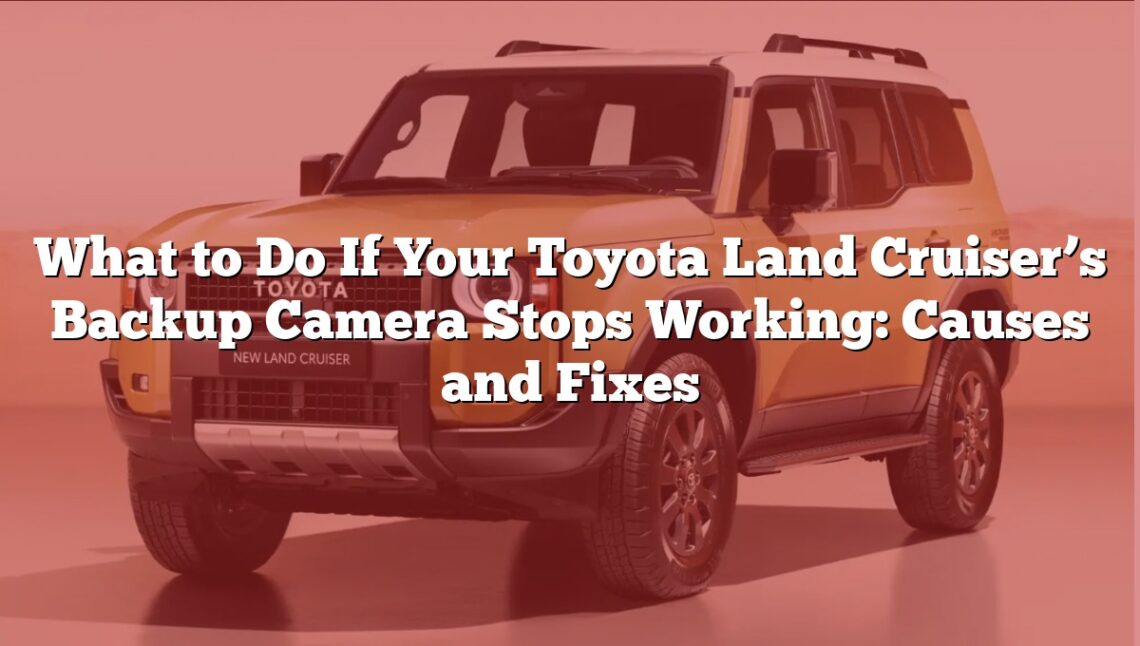A malfunctioning backup camera can be frustrating and even hazardous, especially when you rely on it for safe maneuvering. This guide is designed to help Toyota Land Cruiser owners identify common issues with their backup cameras and provide practical solutions. Whether it’s a simple wiring problem or a more complex system failure, this article breaks down the causes and fixes so you can get your camera working again in no time.
Comprehensive Guide: Common Backup Camera Problems and Their Solutions
| N° | Problem/Cause | Solution |
|---|---|---|
| 1 | Faulty camera hardware | Replace the faulty camera unit. |
| 2 | Damaged or loose wiring connections | Inspect and repair or reconnect the wiring. |
| 3 | Blown fuse | Replace the fuse with one of the correct rating. |
| 4 | Software glitch in the infotainment system | Perform a system reset or software update. |
| 5 | Dirty or obstructed camera lens | Clean the lens with a soft, damp cloth. |
| 6 | Water damage to the camera unit | Replace the camera and check for proper sealing. |
| 7 | Electrical short circuit | Inspect and repair the affected wiring. |
| 8 | Malfunctioning display screen | Diagnose and replace the screen if necessary. |
| 9 | Corroded connectors | Clean or replace the corroded connectors. |
| 10 | Signal interference from other electronic devices | Identify and minimize the source of interference. |
| 11 | Worn-out camera module | Replace the camera module. |
| 12 | Incompatible or outdated software/firmware | Update the software or firmware. |
| 13 | Faulty reverse gear sensor | Replace the reverse gear sensor. |
| 14 | Damage from impact or accident | Repair or replace the camera and check for alignment. |
| 15 | Low-quality aftermarket camera installation | Reinstall or replace with a better-quality camera. |
| 16 | Power supply issues | Verify and restore power to the camera system. |
| 17 | Faulty or damaged video cable | Replace the video cable. |
| 18 | Disconnected camera feed | Reconnect the feed securely. |
| 19 | Internal failure of the infotainment unit | Replace or repair the infotainment system. |
| 20 | Overheating of electronic components | Allow the system to cool; check for cooling issues. |
| 21 | Incorrect settings in the vehicle’s system | Adjust the camera settings via the vehicle’s menu. |
| 22 | Factory defect in the camera assembly | Contact the manufacturer or dealer for repair or replacement. |
| 23 | Failed or damaged control module | Replace the control module. |
| 24 | Sensor calibration issues | Recalibrate the sensors through the vehicle’s service menu or a technician. |
| 25 | Wear and tear from prolonged use | Replace worn-out components as needed. |
| 26 | Environmental influences (rain, snow, fog, extreme temperatures) | Clean the lens and inspect for water intrusion. |
| 27 | Condensation or moisture inside the camera lens | Dry the lens or replace the camera if necessary. |
| 28 | Improper installation or configuration of the camera | Reinstall the camera and configure correctly. |
| 29 | Issues with the camera’s wireless transmitter or receiver | Check connections or replace the transmitter/receiver. |
| 30 | Faulty camera lens alignment after an impact | Adjust or replace the camera alignment. |
| 31 | Aging or degraded plastic or lens cover | Replace the plastic cover or lens. |
| 32 | Failure of the car’s reverse gear sensor to trigger the camera | Replace or repair the reverse gear sensor. |
| 33 | Physical damage to camera wires through repeated motion or hinge stress | Inspect and repair or replace damaged wires. |
| 34 | Recalls or factory defects requiring software updates | Check for recalls and apply updates as necessary. |
Detailed Guide: Common Backup Camera Problems and Their Solutions
1. Faulty Camera Hardware
Reason:
- The backup camera unit itself is damaged or has internal failures, rendering it non-functional.
Solution:
Replace the faulty camera unit with a new one. Ensure you purchase a camera compatible with your vehicle’s model. Consult your vehicle’s manual for installation guidelines or seek professional assistance.
2. Damaged or Loose Wiring Connections
Reason:
- Wires connecting the camera to the display or power source are damaged.
- Connections are loose due to wear and tear or improper installation.
Solution:
Inspect all wiring connections:
- Check for visible damage or fraying.
- Tighten loose connections.
- Replace any damaged wires.
Ensure wires running through hinges or tight spaces are properly insulated to prevent further issues.
3. Blown Fuse
Reason:
The fuse responsible for the camera’s power supply has blown due to a power surge or short circuit.
Solution:
- Locate the fuse box using your vehicle’s manual.
- Identify the backup camera fuse.
- Replace it with a fuse of the same amperage rating.
If the new fuse blows quickly, have the electrical system inspected for deeper issues.
4. Software Glitch in the Infotainment System
Reason:
- Bugs or glitches in the vehicle’s software prevent the camera from functioning.
- Software updates were not applied properly.
Solution:
- Restart the infotainment system by turning the vehicle off and on.
- Check for software updates in the settings menu or contact the manufacturer for the latest version.
- Perform a factory reset if issues persist (refer to the manual for instructions).
5. Dirty or Obstructed Camera Lens
Reason:
- Dirt, grime, or debris blocks the camera lens.
- Snow, rain, or mud covers the lens.
Solution:
- Gently clean the lens using a soft, damp cloth or microfiber cloth.
- Avoid abrasive cleaners that could scratch the lens.
- If persistent dirt or smudging occurs, consider applying a hydrophobic coating to the lens.
6. Water Damage to the Camera Unit
Reason:
- Water has seeped into the camera housing due to improper sealing.
- Prolonged exposure to rain or washing without protection.
Solution:
- Replace the damaged camera unit.
- Seal the new camera housing with waterproof materials to prevent future damage.
- Test for leaks after installation.
7. Electrical Short Circuit
Reason:
- Exposed or damaged wires cause a short circuit.
- Faulty components disrupt the electrical flow.
Solution:
Inspect the entire camera circuit:
- Look for exposed wires or burn marks.
- Replace damaged wires and insulate exposed areas.
- Check connectors for proper fit and functionality.
8. Malfunctioning Display Screen
Reason:
- The screen that displays the camera feed is faulty.
- The wiring connecting the screen to the camera is damaged.
Solution:
- Test the screen with another input to confirm the issue.
- Replace or repair the screen if necessary.
- Ensure all connecting cables are securely attached.
9. Corroded Connectors
Reason:
Connectors exposed to moisture or environmental conditions become corroded, disrupting the signal.
Solution:
- Clean corroded connectors using an electronic contact cleaner.
- Replace heavily corroded connectors.
- Apply anti-corrosion spray for protection.
10. Signal Interference from Other Electronic Devices
Reason:
Nearby electronic devices or systems interfere with the camera’s signal.
Solution:
- Identify and minimize the source of interference.
- Relocate interfering devices if possible.
- Consider using shielded cables or signal boosters for the camera system.
11. Worn-Out Camera Module
Reason:
The camera module has degraded due to prolonged use or poor manufacturing.
Solution:
Replace the worn-out module with a high-quality replacement. Verify compatibility with your vehicle before purchasing.
12. Incompatible or Outdated Software/Firmware
Reason:
- The camera system software is not up-to-date.
- Firmware is incompatible with newer components.
Solution:
- Update the software/firmware through the manufacturer’s website or dealership.
- Verify the update was applied successfully.
13. Faulty Reverse Gear Sensor
Reason:
The reverse gear sensor fails to signal the camera when the vehicle is shifted into reverse.
Solution:
- Replace the reverse gear sensor.
- Test the new sensor to ensure proper functionality.
14. Damage from Impact or Accident
Reason:
The camera or its components have been damaged by a collision or impact.
Solution:
- Inspect the camera and surrounding area for physical damage.
- Replace or realign the camera if necessary.
15. Low-Quality Aftermarket Camera Installation
Reason:
An aftermarket camera of poor quality fails to meet the required standards.
Solution:
- Replace the aftermarket camera with a higher-quality unit.
- Ensure professional installation for best results.
16. Power Supply Issues
Reason:
The camera is not receiving power due to a disconnected or faulty power source.
Solution:
- Test the power supply using a multimeter.
- Reconnect or replace the power source as needed.
17. Faulty or Damaged Video Cable
Reason:
- The video cable connecting the camera to the display is damaged or worn out.
- Loose or improperly connected cables disrupt the signal.
Solution:
- Inspect the video cable for physical damage, such as fraying or bending.
- Replace the damaged cable with a compatible new one.
- Ensure secure connections at both the camera and display ends.
18. Disconnected Camera Feed
Reason:
The feed from the camera to the display unit is disconnected due to loose plugs or damage during maintenance.
Solution:
- Recheck all connections between the camera and the infotainment system.
- Plug in any disconnected cables securely.
- Test the camera feed by shifting into reverse and observing the display.
19. Internal Failure of the Infotainment Unit
Reason:
The infotainment system itself has internal faults, preventing it from processing or displaying the camera feed.
Solution:
- Perform a system reset by following the vehicle manual instructions.
- If the problem persists, consult a professional to repair or replace the infotainment unit.
20. Overheating of Electronic Components
Reason:
Prolonged use or exposure to high temperatures causes overheating of the camera or associated components.
Solution:
- Allow the system to cool by turning off the vehicle.
- Inspect for ventilation or cooling issues around the camera system.
- Replace overheating components if necessary.
21. Incorrect Settings in the Vehicle’s System
Reason:
Camera settings are misconfigured, leading to improper operation.
Solution:
- Navigate to the camera settings in the infotainment menu.
- Restore default settings or adjust configurations such as brightness and alignment.
- Save the settings and test the camera.
22. Factory Defect in the Camera Assembly
Reason:
The camera unit has a manufacturing defect affecting its performance.
Solution:
- Contact the manufacturer or dealer to check if the issue is covered under warranty.
- Replace the defective unit with a new one provided by the dealer.
23. Failed or Damaged Control Module
Reason:
The control module that manages the camera system is faulty or damaged.
Solution:
- Replace the control module with a compatible unit.
- Ensure proper calibration and configuration after installation.
24. Sensor Calibration Issues
Reason:
The camera or associated sensors are misaligned or uncalibrated, resulting in incorrect or no feed.
Solution:
- Recalibrate the sensors using the vehicle’s service menu or professional equipment.
- If manual calibration is required, follow the steps provided in the vehicle manual.
25. Wear and Tear from Prolonged Use
Reason:
Components of the camera system degrade over time due to regular use.
Solution:
- Inspect all components, including the camera, cables, and connectors, for signs of wear.
- Replace worn-out parts with new ones to restore functionality.
26. Environmental Influences (Rain, Snow, Fog, Extreme Temperatures)
Reason:
- Weather conditions obstruct the camera lens or damage sensitive components.
- Extreme temperatures exceed the operational range of the camera.
Solution:
- Clean the lens and ensure it is free of dirt or snow.
- Protect the camera with weather-resistant covers if needed.
- Replace components damaged by extreme temperatures.
27. Condensation or Moisture Inside the Camera Lens
Reason:
Water vapor collects inside the camera lens, distorting the image or blocking visibility.
Solution:
- Remove the camera and allow it to dry in a controlled environment.
- Replace the unit if condensation persists.
- Seal the camera housing properly to prevent future moisture entry.
28. Improper Installation or Configuration of the Camera
Reason:
- The camera is installed incorrectly.
- System configurations do not match the camera setup.
Solution:
- Reinstall the camera according to manufacturer guidelines.
- Adjust the system settings to match the camera’s orientation and specifications.
29. Issues with the Camera’s Wireless Transmitter or Receiver
Reason:
- The wireless transmitter or receiver fails to communicate signals properly.
- Weak signals or dead batteries disrupt functionality.
Solution:
- Replace the batteries in the wireless transmitter/receiver.
- Check the range and ensure no physical obstructions are blocking the signal.
- Replace faulty wireless components if needed.
30. Faulty Camera Lens Alignment After an Impact
Reason:
A collision or accidental bump misaligns the camera, distorting the view.
Solution:
- Adjust the lens manually to restore proper alignment.
- If adjustment is not possible, replace the misaligned camera with a new unit.
31. Aging or Degraded Plastic or Lens Cover
Reason:
The plastic housing or lens cover becomes opaque or brittle over time.
Solution:
- Replace the degraded lens cover with a new one.
- Consider upgrading to a more durable material if available.
32. Failure of the Car’s Reverse Gear Sensor to Trigger the Camera
Reason:
The reverse gear sensor fails to activate the camera when reverse is engaged.
Solution:
- Replace the reverse gear sensor.
- Test the system after installation to ensure proper functionality.
33. Physical Damage to Camera Wires Through Repeated Motion or Hinge Stress
Reason:
Repeated opening and closing of vehicle parts (e.g., trunk or tailgate) wear down the wires.
Solution:
- Inspect the wiring near hinges or moving parts for damage.
- Replace damaged wires and protect them with flexible conduit.
34. Recalls or Factory Defects Requiring Software Updates
Reason:
The camera system has known defects or requires critical updates from the manufacturer.
Solution:
- Check for recalls using the National Highway Traffic Safety Administration (NHTSA) website or your vehicle VIN.
- Apply any available updates through the dealership or manufacturer.
- If replacement is necessary, ensure the new component is fully updated.
Preventing Future Issues
To avoid recurring problems with your backup camera system, follow these preventive steps:
- Regular Cleaning
- Clean the camera lens weekly using a microfiber cloth to remove dirt, grime, or water spots.
- Apply a hydrophobic coating to the lens to prevent water and dirt buildup.
- Inspect Wiring and Connections
- Perform a visual inspection of the wires and connectors every three months.
- Look for signs of fraying, corrosion, or loose connections, especially near hinges or moving parts.
- Protect the Camera From Environmental Damage
- Use a weather-resistant cover for the camera if your area experiences extreme weather conditions.
- Park in a garage or shaded area to protect the system from prolonged exposure to extreme temperatures.
- Update Software Regularly
- Check for updates to your vehicle’s infotainment system or camera software every six months.
- Install updates promptly to fix bugs and ensure compatibility with new features.
- Test the System Periodically
- Shift into reverse and check the camera’s feed weekly to ensure it displays correctly.
- Note any delays, distortions, or issues that might indicate a developing problem.
- Perform Professional Maintenance
- Schedule an annual inspection with a certified technician to test the camera system thoroughly.
- Address any potential issues, such as minor misalignments or wear, before they escalate.
- Avoid Overloading Electrical Systems
- Prevent overloading the vehicle’s electrical circuits by avoiding the use of high-power accessories while the camera is active.
- Ensure all aftermarket accessories are professionally installed and compatible with your vehicle.
- Check for Recalls
- Visit the manufacturer’s website or the NHTSA website periodically to check for any recalls or notices related to the backup camera system.
- Address recalls immediately to prevent potential failures.
By following these steps, you can minimize the risk of backup camera issues and ensure the system continues to operate effectively for years to come.







